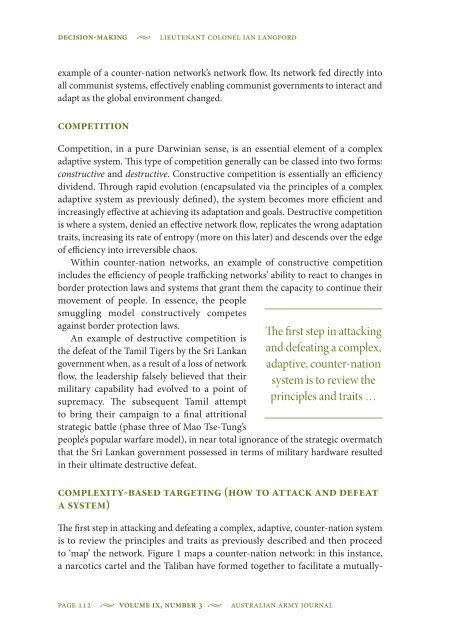Understanding and Defeating a Complex Adaptive ... - Australian Army
Understanding and Defeating a Complex Adaptive ... - Australian Army
Understanding and Defeating a Complex Adaptive ... - Australian Army
You also want an ePaper? Increase the reach of your titles
YUMPU automatically turns print PDFs into web optimized ePapers that Google loves.
Decision-Making • Lieutenant Colonel Ian Langford<br />
example of a counter-nation network’s network flow. Its network fed directly into<br />
all communist systems, effectively enabling communist governments to interact <strong>and</strong><br />
adapt as the global environment changed.<br />
Competition<br />
Competition, in a pure Darwinian sense, is an essential element of a complex<br />
adaptive system. This type of competition generally can be classed into two forms:<br />
constructive <strong>and</strong> destructive. Constructive competition is essentially an efficiency<br />
dividend. Through rapid evolution (encapsulated via the principles of a complex<br />
adaptive system as previously defined), the system becomes more efficient <strong>and</strong><br />
increasingly effective at achieving its adaptation <strong>and</strong> goals. Destructive competition<br />
is where a system, denied an effective network flow, replicates the wrong adaptation<br />
traits, increasing its rate of entropy (more on this later) <strong>and</strong> descends over the edge<br />
of efficiency into irreversible chaos.<br />
Within counter-nation networks, an example of constructive competition<br />
includes the efficiency of people trafficking networks’ ability to react to changes in<br />
border protection laws <strong>and</strong> systems that grant them the capacity to continue their<br />
movement of people. In essence, the people<br />
smuggling model constructively competes<br />
against border protection laws.<br />
An example of destructive competition is<br />
the defeat of the Tamil Tigers by the Sri Lankan<br />
government when, as a result of a loss of network<br />
flow, the leadership falsely believed that their<br />
military capability had evolved to a point of<br />
supremacy. The subsequent Tamil attempt<br />
to bring their campaign to a final attritional<br />
strategic battle (phase three of Mao Tse-Tung’s<br />
The first step in attacking<br />
<strong>and</strong> defeating a complex,<br />
adaptive, counter-nation<br />
system is to review the<br />
principles <strong>and</strong> traits …<br />
people’s popular warfare model), in near total ignorance of the strategic overmatch<br />
that the Sri Lankan government possessed in terms of military hardware resulted<br />
in their ultimate destructive defeat.<br />
<strong>Complex</strong>ity-based targeting (how to attack <strong>and</strong> defeat<br />
a system)<br />
The first step in attacking <strong>and</strong> defeating a complex, adaptive, counter-nation system<br />
is to review the principles <strong>and</strong> traits as previously described <strong>and</strong> then proceed<br />
to ‘map’ the network. Figure 1 maps a counter-nation network: in this instance,<br />
a narcotics cartel <strong>and</strong> the Taliban have formed together to facilitate a mutually-<br />
page 112 • Volume IX, Number 3 • <strong>Australian</strong> <strong>Army</strong> Journal

















